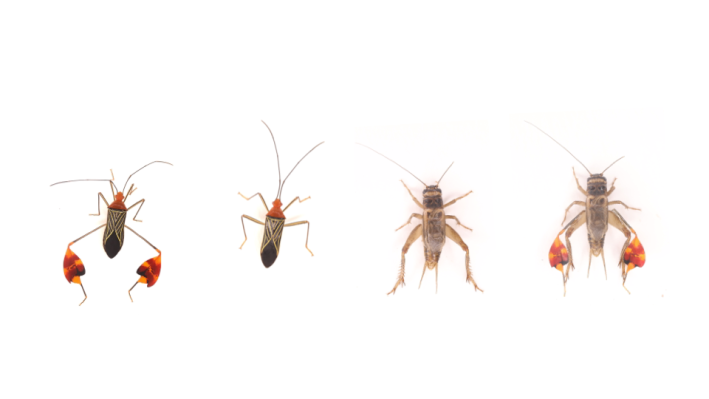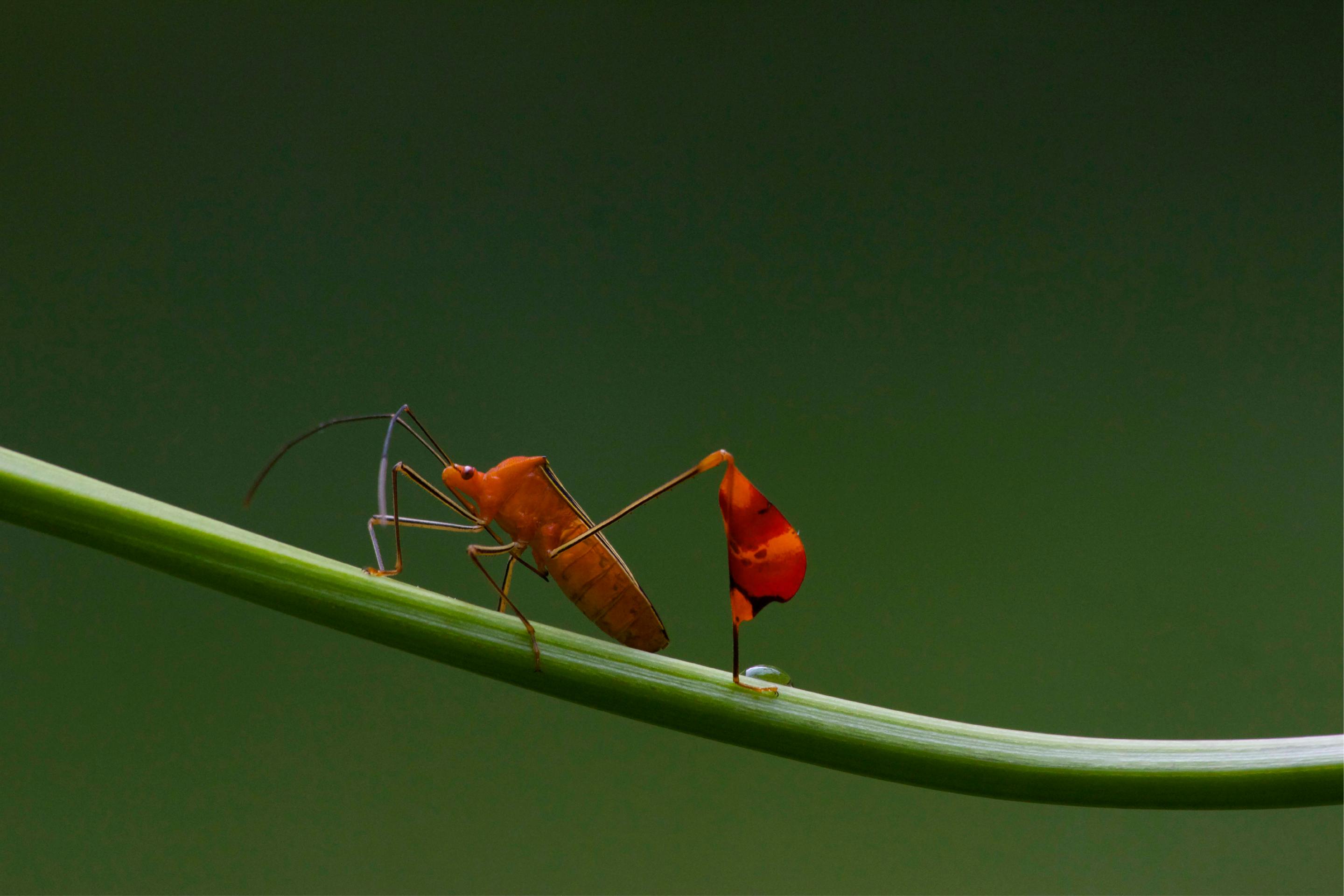If you approach a matador bug, it will, as its name suggests, wave the big red flags on its legs like a seasoned bullfighter. Unlike a bullfighter, the bug must lift both its back legs and twirl them around to create its flag-waving display. To Ummat Somjee, an evolutionary biologist at the Smithsonian Tropical Research Institute in Panama, the bug seemed to be saying: "Hey! Here I am!"
Fittingly, the fanciful legs of the matador bug have made the bug a muse of many photographers and even graced the cover of an edition of Lonely Planet. Juliette Rubin, an evolutionary biologist and behavioral ecologist at the same institute, noticed the beautiful bug on one of the institute's coffee table books, placed, appropriately, on one of the institute's coffee tables. "It was an animal that I had seen just because it had previously been in my visual repertoire, because it's a beautiful insect," Rubin said. Somjee said he "assumed that people had studied it." But when the researchers looked into the literature, they found no research investigating why the bugs had such dramatic leg flags, let alone why they waved them.
Somjee previously studied giraffe weevils, whose males have laughably elongated snouts, and Heliconia bugs, whose males have a pair of swole, spiny legs—both features used to fight other males. The most obvious explanation for creatures expending precious energy on an extreme body part that does not offer a clear survival advantage is sexual selection. But both male and female matador bugs have big red flags, and even sexually immature nymphs have red flags of their own. In 2022, Rubin, Somjee, and colleagues concluded that the bug's fancy legs likely had little to do with sex.
Perhaps the legs were a colorful diversion to help the bugs escape. Matador bugs are known to shear off their own their hind legs in an instant—a deflection mechanism that protects the insect's more precious body parts, explains Zachary Emberts, a behavioral ecologist and evolutionary biologist at Oklahoma State University. "As opposed to my head, just take my leg!" Or perhaps the leg flags were a warning signal like those of poison dart frogs, warning would-be predators of the bug's chemical defenses. In a paper recently published in the journal Behavioral Ecology, Rubin, Somjee, and colleagues suggest the latter explanation is true—the flags appear to warn away hungry birds.
The researchers decided to test the effects the flags had on one of the matador bug's predators. To do this, they needed predators and prey. Jorge L. Medina-Madrid, a researcher at the institute and an author on the paper, led efforts to place mist nets around Soberanía National Park in Gamboa, Panamá and play callback sounds from speakers to attract two species of motmots, iridescent birds with tailfeathers shaped like pendulums. The motmots would spend just a few days with the researchers before being returned to the wild.
Matador bugs are hard to locate in the wild, so Somjee spent about a year learning how to rear the bugs in captivity. The bugs live in "La Chincheria," or the bug hut—a little greenhouse teeming with different species of passion fruit plants. This is how he learned that even immature bugs have flags, and they even practice lifting their legs and waving. "It was really cute," Somjee said. "I was like, 'Oh my gosh, that was a little wave. You just did a little wave!'" Rather charmingly, the bugs sometimes release a surprising odor when startled, which Rubin likened to green apple.

After a newly captured motmot bird spent the night in a small aviary, where they learned to eat tasty snacks of mealworms and cockroaches served on a platform, the experiments begun. The researchers offered each bird a variety of prey items, including a delicious cricket—a meal nearly universally beloved among birds—a matador bug, a denuded matador bug with its hind flags removed, and a cricket disguised as a matador bug, with flags glued to its hind legs. To keep the prey on the platform, the researchers designed tiny cricket leashes: a stretch of fishing line attached to glue that a cricket could not escape but would pop off under pressure, such as the kind applied by a bird's beak.
As the researchers watched recordings of the motmots' attacks on the disguised crickets, they realized the birds targeted the cricket's body, not its flags, eliminating the deflection hypothesis. Emberts was surprised by this finding, as the bugs' ability to quickly amputate their legs seemed similar to lizards that shed their tails. The motmots actively avoided the matador bugs, both those with and without their flags, and were less likely to attack crickets costumed as matadors. "Even without the flags, the bird was able to identify the bug without flags as something that would probably taste bad," Rubin said. So while the flags are a big signal, the birds can still tell a denuded matador bug tastes bad. And some particularly dexterous motmots managed to tear the attached flag legs off crickets to make their meals entirely palatable. "It's hard to fool these bugs," Somjee said.
The study's motmots may have already learned to avoid the matador bugs in the wild. To confirm that matador bugs do in fact have a chemical defense that makes them taste bad, the researchers needed a naive predator that had never seen a bug before in their life. Somjee went to Panama City and bought a box of 21 young chickens and reared them in the aviary on chicken feed, ensuring the young birds would not see a single insect—a difficult task in the tropics.
The chicks proved a challenge of their own. "These chicks were very vocal," Somjee said. "As soon as I walked into the cage, they would come in yelling." When the researchers tried offering a lone chick a cricket on the platform, the chick could not concentrate on its task. "We had to have this buddy chick system, where we had a chick that was just there for emotional support," Somjee said. Once a chick had a buddy by its side in a separate, smaller cage, it readily ate prey off the platform, including delectable mealworms and crickets. After three chicks ate matador bugs, they shook their heads to indicate the bugs did not taste good.
After the experiments, the researchers donated the chicks to someone in a local village. Somjee handed off the box of chicks to a 12-year-old in a canoe, who paddled away happily with his new cargo. "For almost a year afterwards, they sent me pictures of the chicks walking around the village, eating bugs," Somjee said.
Somjee and Rubin hope to continue this matador bug research with new subjects to see how the bug's flags affect different species of predator, which might have played a role in the trait's evolution. "There's hundreds of other predators that feed on the bugs," Somjee said. Rubin suggested that arthropod predators "may be more susceptible to being fooled by these waving flags as decoys." Although neither Somjee nor Rubin have ever eaten a matador bug—Somjee said he's accidentally tasted one—they recognize they are not too different from the forest's other predators. "We are visual animals," Rubin said. "The reason I was drawn to them was because they were huge and weird and bizarre, and they were waving at me," Somjee said. "But that's exactly what they evolved to do. They evolved to be noticeable, to be flashy, and to draw attention."






